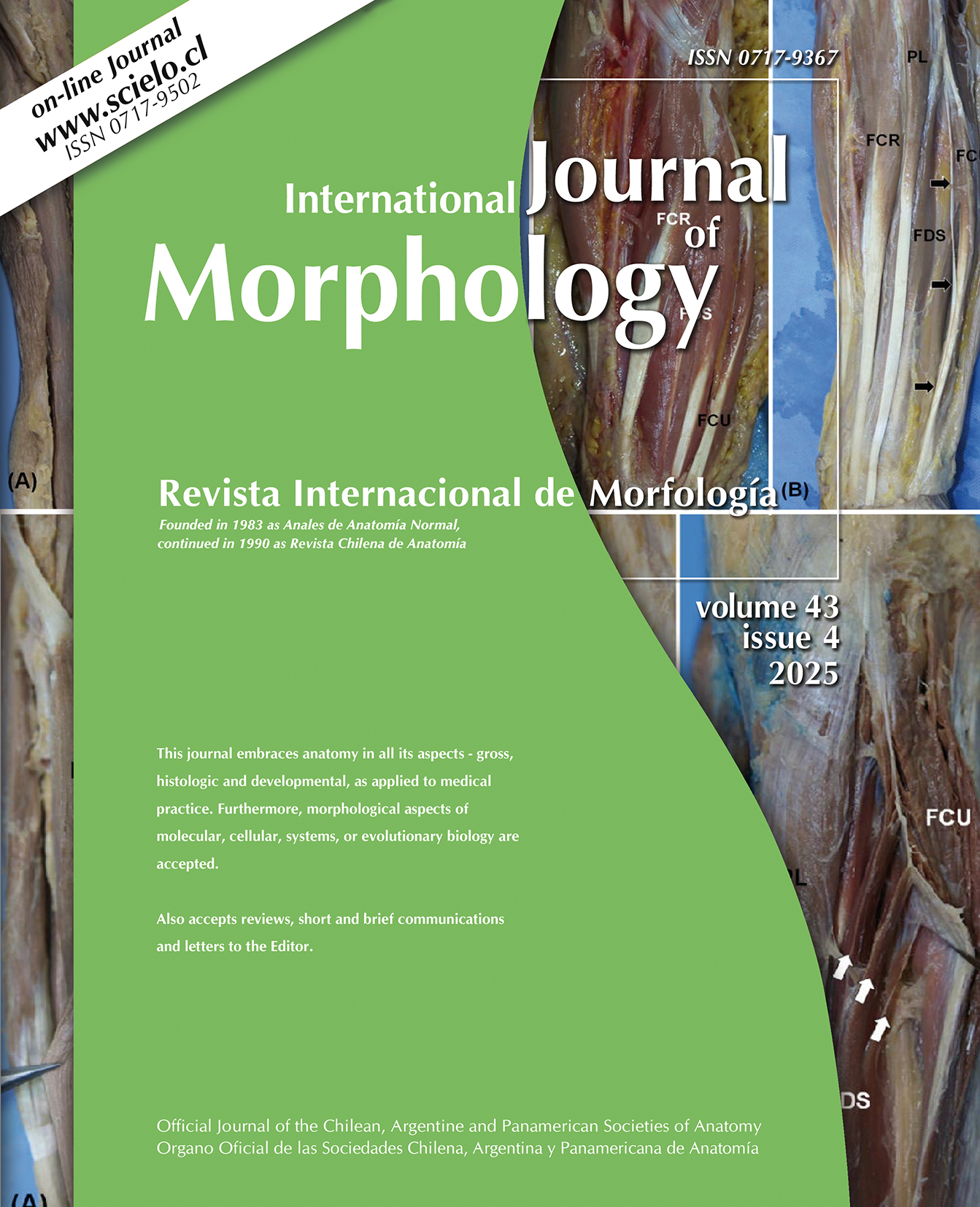On the Article: “History of Anatomy in Chile. The Beginnings”. Some Quechua Anatomical Terms Used in Chile
DOI :
Manuel E. Cortés
Summary
To the Editor:
In his interesting historical article published in the International Journal of Morphology, Cárdenas Valenzuela (2017) mentions that the anatomy practised on the corpses of aboriginal individuals in Chile was oriented mainly on the conservation of the bodies for religious reasons and the search for an explanation for the origin of some diseases, rather than to the study itself. This author also highlighted that some of these terms were incorporated into our usual Chilean Spanish language, e.g., “guata”, which derives from the Quechuan word huatha, the name for the abdomen, and “chunchules” (beef small intestine which may be grilled or fried), which derives from the Quechuan word chunchuli, referring to the intestines (Cárdenas Valenzuela, 2017). With the interest of determining the loanwords of this language to the Chilean Spanish dialects, especially the Quechuan contributions observed in anatomical names that are still used in Chile and given that the aforementioned article does not deepen into it, this Letter to the Editor aims to present a list of Quechua anatomical terms commonly used in some areas of Chile.In South America, the Incas established the Empire of the Sun (Tawantinsuyu, Quechua for the “Realm of the Four Parts”), extending from the Pacific Ocean coast to the Andes and from Ecuador to Chile. It was an advanced civilisation whose common language was Quechua (Fadl, 2014). Before the arrival of Diego de Almagro in 1536, the present day territory of Chile had been the object of two invasions carried out by the Inca monarchs. The first was in 1460, undertaken by Tupac Yupanqui, which reached the Cachapoal River; the second, led by his successor Huayna Capac, who managed to cross the Maule River but had to retreat due to the fierce resistance of the Promaucae (Prieto, 2006). As a result of this enterprise of conquest, the
inhabitants of the recently dominated territory (i.e., Atacameños, Diaguitas and Picunches) were subjected without offering much resistance since they could not face the invaders’ military organisation. Then, the Incasian empire expanded its already vast domains, which included the regions of Ecuador, Peru, Bolivia, and Northwestern Argen- tina, up to the northern bank of the Maule River, thus occupying an immense and vast area (Prieto, 2006). This intercultural and interlinguistic contact in the current Chilean territory led the Mapuche people to incorporate several Quechua words into their language, and many words formed with Quechua roots (Prieto, 2006).Based on a historiographical approach, which included searching in specialised texts, indexed journals and integrating some field work testimonials, it was found that currently, in the Coquimbo Region, it is possible to listen to the people using various loanwords from Quechua (and most likely, other languages) in everyday speech when referring to some structures of the human body or some pathophysiological conditions. For example, in the Limarí Province, the navel is called pupo, caracha is the “scab” that appears on a wound after healing, and chupo is a “large pimple on the skin”, infected and containing pus, which is consistent with the information reported by some researchers (Domínguez, 2004; Prieto, 2006; Carvajal, 2021). Less frequent, but a term that is still heard in the Limarí valleys (e.g., inland of Ovalle), as well as in the Choapa Province (e.g., Illapel) is tuluco, which is a “hardening or rounded numbness” resulting from swelling (Carvajal, 2021). To des- cribe this, sometimes the Quechua word used is cototo, meaning “bump” or “swelling”, consistent with a previous report by Meyer (1952). As reported by Fadl (2014), it is common in the Coquimbo Region to hear the Quechua term ñato, a derogatory way referring to a person or animal with a “flattened nose” while curco is called a hunchbacked or stooped person (Prieto, 2006). Throughout Chile, the use of the term poto (cfr. mochica poto, meaning “container for chicha” or buttocks) refers to the “butt” or “buttocks” (Carranza, 2003; Carvajal, 2021); while in Santiago, it is common to show empathy for the person who is suffering from pain with the word nanai, probably derived from the Quechua nana, which it means “pain”, and this term is used in the rural regions of Ovalle to refer to a “wound”, as previously reported by Manera (1997). Other anatomical terms, quite common in the Norte Chico, have a vulgar connotation, referring to male genitalia. Table I provides the meaning of several of these terms.
Wagner (2005) states that Aymara, spoken in Bolivia and southern Peru, is the language in contact with the Spanish of Chile in the extreme north. On the other hand, he postulates that the Quechua words used there (some of which can be Quechua-Aymara) are of old date and brought to the north
from the centre of Peru, where the indigenous people of that area had incorporated them into their language, and from this to that of the Spaniards with whom they took contact starting in 1536, or have been introduced more recently through regional Peruvian Spanish (Wagner, 2005).
Although Spanish is widely used, a hypothesis is that these terms still survive quite strongly in the North of Chile since they are transferred familiarly from grandparents; furthermore, these words can be brought to the centre of the country by those who travel to the area due to job opportunities, in addition to the migration phenomena from Peru and Bolivia to Chile.
In conclusion, Chilean Spanish dialects contain several Quechua loanwords —and some from other languages— that refer to anatomical concepts of the human body or pathophysiological conditions. These terms constitute an invaluable cultural heritage that should be known by those dedicated to morphological sciences, particularly in South America.





























